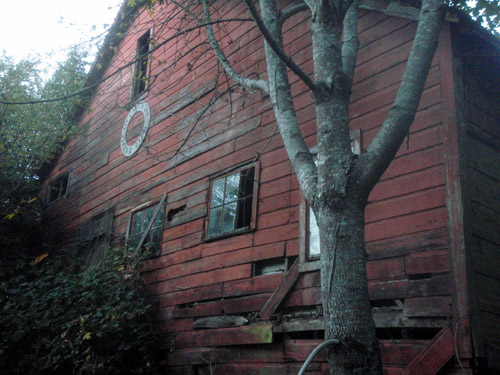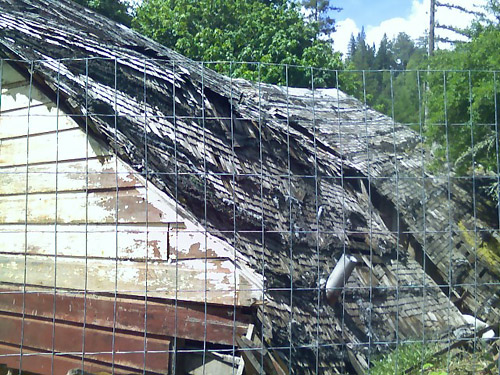
The Occidental Yacht Club in 2009, before it began to seriously buckle
Maybe the Occidental Yacht Club was not such a great idea to begin with. At six hundred feet above sea level, the town of Occidental is a dozen winding miles down to the cliffs and breaks of Sonoma’s unforgiving shores. While I have yet to hear the story of the building’s true origins, I assume an element of comedy was at play, which only adds a veil of elegance to the building’s slow decay.
We’ve been watching the old red barn collapse since we moved up the ridge five years ago, wondering whether it would be rescued or torn down. When the Occidental Farmers Market is in full swing on Friday evenings during the growing season, the collapsing building has been a kind of secret fort for town kids, a site for hide and seek, ghost stories and games of dare. I’ve never been inside, but I’ve entertained my own fantasies wondering about what happened there, what’s buried under the planks. Understandably, the building has recently been cordoned off, condemned, and is now inaccessible to anyone, which got me thinking about the significance of ruins in our daily lives.
I’ve written before about a pattern common to West Sonoma County, the tendency not to maintain old outbuildings but leave them to the elements after they become obsolete. As a native Northeasterner, where old agricultural buildings are either carefully maintained, adapted, restored or disassembled, this has been quite an adjustment, despite the romantic visual appeal of distressed barns in the hay meadow.
I’ve since come to understand that poverty connotes an ethos of conservation that is tuned to regional conditions, material resources and a philosophy of labor. For example, the farmers who built barns and outbuildings on this stretch of the West Coast a century and a half ago typically arrived here by sea, and were familiar with the coastal vernacular of New England. Yet they were availed of open land, fair weather, giant straight-grained redwood trees that far surpassed the forests of yore, and the possibility of forging a new identity. The flavor of their subsistence had more to do with self-sufficiency than community, as is reflected in the ethos of their architecture. It was easier and cheaper to build than to maintain, where the opposite was the case in New England, with dwindling resources and land, and unified expectations for social comportment.
I’ve grown accustomed to the dominant attitude of the rural West Coast, especially as it manifests itself in a preponderance of roadside ruins. I believe the tradeoff of allowing for possibility and imagination, even danger, over expectations of tidiness and order speaks for itself.

a recent view of the roof collapsing
Interesting entry ! Extremely well written !
We have just had the countertop for our kitchen island made out of the beautiful old redwood floor joists from this building. It is a glorious piece, and each piece in it tells a story. I am told that the building has plenty of history – it was at one stage a brothel, also a mechanics shop,owned by the Negri family for many many years, and the owner of the wonderful Heritage Salvage in Petaluma started the Occidental Yacht Club as a local service organization where the motto was, “you need not own a yacht to be a member, you just gotta be a little dingy!”
Wow! What a great story, Mr. Blue, thanks for posting! If you send an image or two of your counter/island I will post them on this page as a follow up: scott@deepcraft.org
-Scott